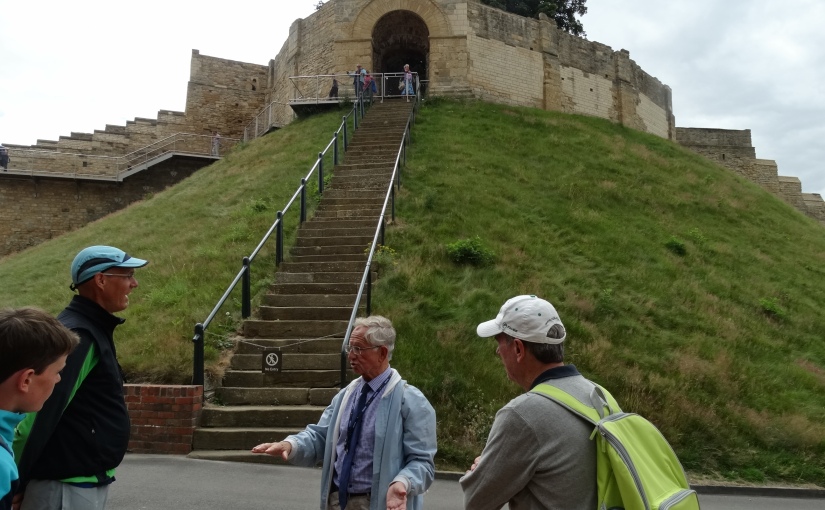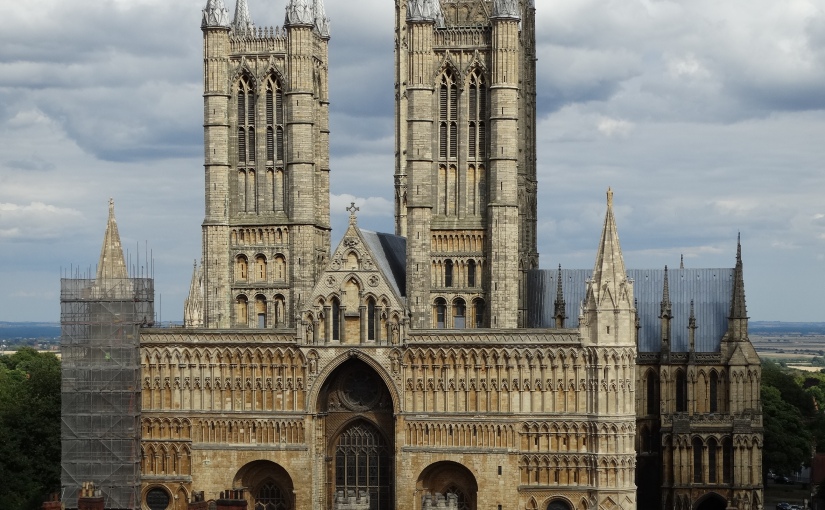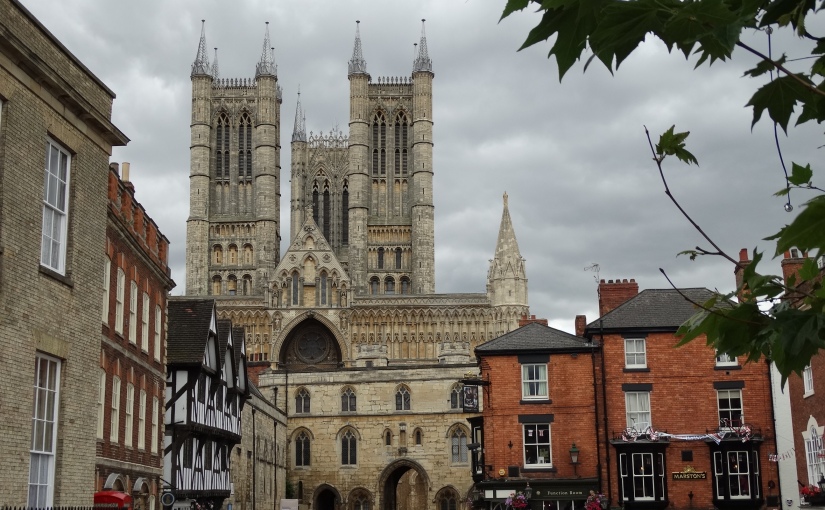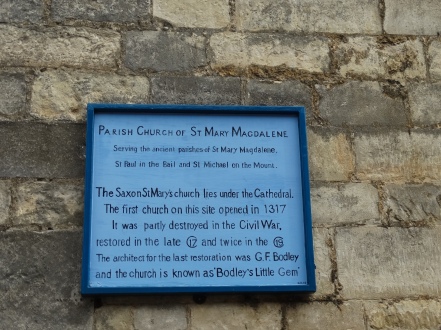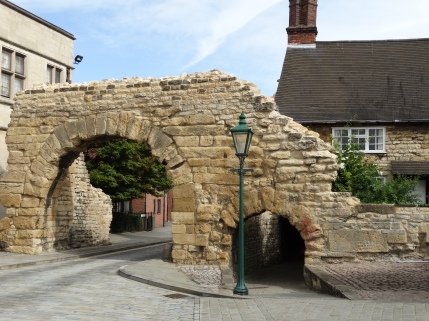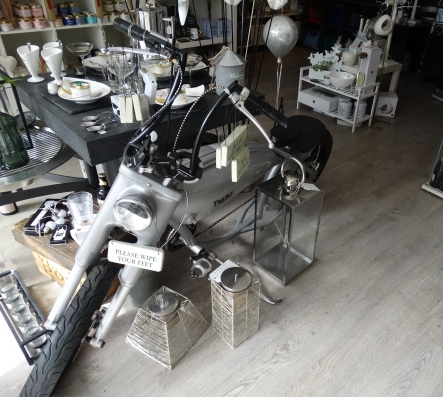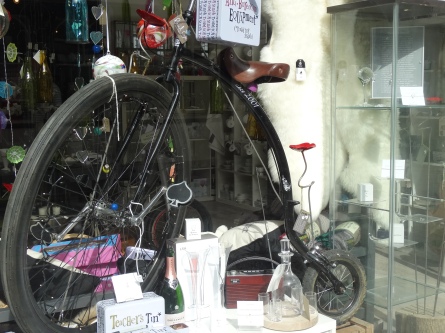The Retirees Go Abroad
Somewhere different – Lincolnshire
It is a grey day. The forecast is for scattered showers across the midlands and the forecast looks pretty accurate. In addition there is a grey mist hanging just above the ground so all in all a great day to stay in bed or visit Lincolnshire. So we decide to visit. But where and what?
We have joined the National Trust and this is proving to be a great investment. So I hop onto the web site and select to visit Tattershall Castle at Tattershall in the north-west and Belton House in nearby Belton Village.
Although Lincoln itself is only 35 mins from Nottingham these places are in the eastern side of the county so we had a 1.5 hour drive to our first stop at Tattershall. Lincolnshire is very agricultural and most of our drive we passed open fields of fertile looking soil going off to the horizon (shrouded in mist today). It has the appearance of being very flat with villages spread out so that the farms appear much larger than down south. I don’t know if that is true but the country side we drove through seemed largely to be farmland. There were a few changes such as the RAF bases (RAF Cranwell RAF Waddington) we passed on the way, an air museum which we will have to visit next time and RAF Coningsby from the turrets of Tattershall Castle. The RAF seems to like Lincolnshire and I have attached a link to the official website of RAF Lincolnshire museums for those interested – http://www.raf-lincolnshire.info/museums.htm.
The road was good but the mist did not leave us and we passed through some small showers/ spits of rain. We arrived at Tattershall around 11.15 am which is good timing as the Castle is not open til 11.00 am. The car park had at least a dozen cars in it surprising for what seemed one of the more remote places we have visited. We walked passed the lawn bowls green into the church yard. Wow!
A surprisingly large church stood there in front of us –the Collegiate Church of the Holy Trinity Tattershall. “The Church of the Holy Trinity at Tattershall was completed in 1500 AD having been endowed, in 1439 by King Henry VI, with Collegiate status. A Collegiate Church is one that has attached to it, a Chapter of canons and prebendaries – priests whose livings are paid through endowments and by the income from land or tithes.” http://www.httf.org/history.html.
From the moment you walked in you knew this was going to be in its original state. The sign at the entrance was the give-away. Inside you could see this was a grand church although somewhat raw by other standards. Still it had a substantial presence and was clearly loved by its community and the local bats who roost in the exterior (and sometimes the interior) of the church. It had an obvious bell tower but the cords were just out of reach. I suspect only part of the church is now used as a consecrated church. The web site above is well worth a visit and I hope my photos give you some idea of the presence of this church. We bought some local baked wares and Kerry found an “antiquities” stall purchasing some bits and pieces for the 50p each.

Welcome

Collegiate Church of the Holy Trinity

The ancient front door

the campanologists ropes

the main chapel in the church

unusual wooden ceiling
Walking from the church we passed under shady trees and through an open area across a timber footbridge into a building called the guardhouse (it may have once served such a purpose but today it is a ticket office gift shop and visitors centre). Immediately in front of us but probably 200 meters away is the only remaining portion of the castle, a six story tower that was once the centre of a fortified castle surrounded by two moats. One of the moats exists today whilst only part of the outer moat remains. Built in 1434 by Ralph Lord Cromwell Treasurer to Henry VI (he also served in the army of Henry IV at Agincourt) it was saved from complete demolition (and pillaging by American entrepreneurs) by Lord Curzon in 1911 and bequeathed to the newly formed National Trust in 1925. When Cromwell died in 1456, the castle was initially inherited by his niece, Joan Bouchier, but was confiscated by the Crown after her husband’s demise. Tattershall castle was recovered in 1560 by Sir Henry Sidney, who sold it to Lord Clinton, later Earl of Lincoln, and it remained with the Earls of Lincoln until 1693. It passed to the Fortesques, but then fell into neglect until bought by Lord Curzon. It remains today one of the three most important surviving brick castles of the mid-fifteenth century.
As we approached the tower we noted that there are foundations for the old kitchens in the moat. These kitchens were connected to the castle along with the guest apartments, the enclosing walls and watch towers. There are three doors at ground level the middle one leads to the basement where the castle servants lived and provisions were stored. The right hand door leads to the parlour where estate business was conducted by the Lord’s warden (tenants paid rent etc). The third doorway on the left is the stair case to the upper floors. On the first floor is the Great Hall where the Lord would wine and dine and entertain guests, the second floor was the Audience Chamber where only special; guests would be entertained, the third floor was the Private Chamber where the Lord retired for the night and the family lived, the fourth floor is the roof and the fifth floor the turrets. The sixth floor is the below ground servants quarters.
In the basement was the well for the castle, on the first and third floors there were garderobes (a medieval toilet – the garderobe on the third floor included the dressing room as it was believed the smell of human urine drove fleas and lice from clothing and this configuration is believed to have led to the word ”wardrobe”). On the second floor a dovecote was installed in one of the anterooms in the 18th century (a dovecote is a nesting construction so that the occupants of the castle had fresh eggs and meat when other sources were not available. For more information go to http://www.nationaltrust.org.uk/tattershall-castle/.

the Gatehouse

Bridge from Gatehouse to Tower grounds

the Tower

the basement

the Parlour

Memorial to Lord Curzon

the Great Hall

Fire place in the Great Hall

the Audience Chamber

the Dovecote

the Main Living area

Tower defences

Looking toward the Gatehouse and Collegiate Church
The visit to the castle was very interesting. Belton House however was entirely different. Built between 1685 and 1689 for Sir John Brownlow–Cust (they did not like the “Cust” so they dropped it despite the added wealth that marriage brought to the family) and often cited as the quintessential country house with a 1300 acre estate and deer herds. Unfortunately only the house was open and the below stairs tour would have to wait for another day. So we keyed in the post code for Belton House and Tommy took us right there – as though it was still 1700. Because Tommy took us to the front gate which these days is locked we alighted and walked the last 1.6 kilometers to the house only to find there is a new entrance from Belton Village to a car park directly alongside the house. We were not the only ones fooled by our GPS.
Even so it was pleasant walking along the avenue. It was still overcast although the mist had lifted about 3.00pm so it was cool walking along watching the deer frolic in front of us. The grounds were lush and the deer prolific. In the distance we could see a grand house in a green sea with figures running around in white. It was a cricket match. Apparently the local cricket team counts the ground in front of the house as their field.
We circumnavigated the pitch and climbed the front stairs into the marble entrance hall filled with family portraits. The house has three storeys above ground and one below. Two storeys are open to visit and the below storey is accessible only by tour. We moved into the saloon with more portraits of the family, to the Viscount Tryconel Room, to the Chapel Drawing room. Here in this room is a Delander long case clock made in the 18th century showing not only the time but has an in built calendar – a Julian calendar (a bit like a betamax video recorder wrong technology). Beside this room is the chapel which is actually in the basement and we were standing in the organ room overlooking the chapel. The organ retracted into the wall. In the Chapel Drawing room we had the opportunity to see the original colour of the room (a brilliant Lapis blue with gold and white flecks) and the degraded colour after 300 years.
In the Blue Dressing Room we saw the Lapis cabinet of 21 draws two of which were secret drawers. Italian made it is completely decorated in lapis lazuli, the favoured precious stone of the Pharohs. There was also a portrait of Richard Brownlow founder of the family fortunes and the Chief Prothonotary of Queen Elizabeth I’s Court of Common Pleas (principal clerk of the court). There are 3 main staircases in the house (not counting the hidden staff stair cases) and at this point we entered the Little Marble Hall and went upstairs. They did not forget the Cust family altogether as there is a bust of Harry in the West Stair case
Upstairs we saw the bedroom which is a bit unusual in these old country houses. There was the Queen’s bedroom and the Windsor bedroom with ensuite (Prince Charles stayed here while training at the RAF base at Waddington and I found two “toby” jugs in this room one portraying George V and the other Winston Churchill). There was the library and then the study which looked like a second library, the Red Drawing Room and then down the west staircase to the tapestry room but we could not go into the breakfast room (they had hosted a showing of the silver ware from No 10 Downing St and had not cleaned up after 17,000 people visited the display.
We then ventured out to the stables (now the shop, café, book shop etc etc,) and into the ornate Italian garden. Like all of these gardens just beautiful. The topiary was fascinating as it waved through the trees with no particular shape but joining them all together as a green wall. The Orangery (hothouse) was filled with sub – tropical plants and behind it was a formal Dutch garden. Hidden in the trees was the family church and crypt. All the Brownlow’s are there including one pair who died in 1670’s.
We needed a cup of coffee and to sit down for a rest because we now had the walk back to the car. The deer had coalesced into a larger herd but still there were the odd few rambling about as we walked back to THISTLE. The sun had finally come out we warmed up walking to the car. Our trip had ended and we now had 34 miles (yes they still use miles in the UK) to go to return to Nottingham.

Only 1.6 klm to go

Hows zat

Thistle is down there somewhere

One of the early Brownlows

Looking into the Chapel

compare the colours

Lapis Lazuli cabinet

Some of the crockery

Winston and George “toby” mugs

A prince’s bed

the Tapestries

the Entry

the Italian Garden

Some of the flowers

From the Orangerie

Some more of the flowers

Part of the topiary wall

In the church – the 17 th century crypt
Share this: Feel free to share

